Grand Canyon Railway facts for kids
Quick facts for kids Grand Canyon Railway |
|
|---|---|
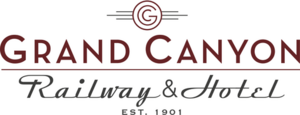 |
|

Ex-Chicago Burlington and Quincy 4960 on the Grand Canyon Railway
|
|
| Locale | Coconino County, Arizona, US |
| Terminus | Grand Canyon Village |
| Commercial operations | |
| Built by | Atchison, Topeka and Santa Fe Railway |
| Original gauge | 4 ft 8 1⁄2 in (1,435 mm) standard gauge |
| Preserved operations | |
| Owned by | Xanterra Parks and Resorts |
| Operated by | Grand Canyon Railway |
| Reporting mark | GCRY |
| Length | 64 mi (103 km) |
| Preserved gauge | 4 ft 8 1⁄2 in (1,435 mm) standard gauge |
| Commercial history | |
| Opened | 1901 |
| Closed to passengers | 1968 |
| Closed | 1974 |
| Preservation history | |
| 1988 | Max and Thelma Biegert Ownership |
| 1989 | reopened |
| 2006 | Xanterra ownership |
| Headquarters | Williams |
The Grand Canyon Railway (reporting mark GCRX) is a special train line. It takes passengers between Williams, Arizona and the South Rim of Grand Canyon National Park. It's a fun way to see the Grand Canyon!
This railway is 64-mile (103-kilometer) long. The Atchison, Topeka and Santa Fe Railway built it. It was finished on September 17, 1901. When trains started arriving, more people visited the Grand Canyon. The railway even helped create the Grand Canyon Village. This village was built to serve all the new visitors.
But then, cars became very popular. Fewer people rode the train. So, the Atchison, Topeka and Santa Fe Railway stopped passenger service in July 1968. Freight service, which carries goods, ended in 1974.
In 1988, some private investors bought the railway. They fixed it up and started running passenger trains again. This happened on September 17, 1989. Today, the Grand Canyon Railway carries many people. It runs all year long, taking visitors to and from the canyon.
The entire Grand Canyon Railway is now on the National Register of Historic Places. This means it's recognized for its important part in American history.
Contents
History of the Grand Canyon Railway
Early Days: Santa Fe Ownership
In 1901, the Atchison, Topeka and Santa Fe Railway built a branch line. This line went from Williams to Grand Canyon Village. The first train with paying passengers arrived on September 17, 1901. The trip was 64-mile (103-kilometer) long. It cost $3.95 back then.
A famous nature expert, John Muir, praised the railroad. He said it didn't harm the natural environment much. To help travelers, the Santa Fe company built the El Tovar Hotel. It opened in January 1905. The hotel was only 20 feet (6.1 meters) from the Canyon Rim.
Over time, more and more people started driving cars. This meant fewer people rode the train. So, the Santa Fe company stopped the Grand Canyon Railway passenger service in July 1968. Only three passengers were on the very last trip! The tracks were still used for freight until 1974.
After it closed, some people tried to bring the railway back. Entertainer Arthur Godfrey tried in 1977, but it didn't work out. Two other companies also tried in 1980 and 1984. These attempts helped keep interest alive. They saved the line from being taken apart.
New Owners: Max and Thelma Biegert
In 1988, a couple from Phoenix, Arizona, Max and Thelma Biegert, bought the railway. They fixed it up. In 1989, the railway started running again. It was now a separate company, not part of Santa Fe. The first trip of the restored railway was on September 17, 1989. This was exactly 88 years after the original opening day!
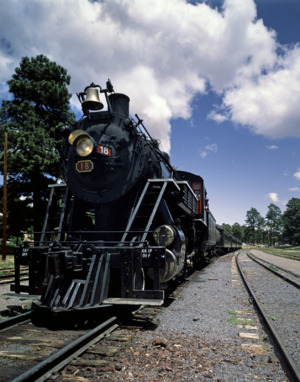
The Biegerts were from Nebraska. They had made a lot of money in crop dusting. This is a business that sprays crops from airplanes. They also ran a day care business. They didn't plan to get into the train business. They had loaned money to someone who owned the tracks. When that person couldn't pay them back, the Biegerts ended up owning the railway.
The railway bought its first locomotives. These included two GP7u diesel engines from Santa Fe. They also got four 2-8-0 consolidation steam locomotives. These steam engines used to run on the Lake Superior and Ishpeming Railroad.
In the early 1990s, the Grand Canyon Railway bought more diesel engines. These were 1950s-era ALCO FA diesel-electric locomotives. They have a cool "snub nose" design. These new diesel engines helped the railway run all year. In 1996, they added another steam engine. This was former Chicago Burlington and Quincy 4960. This engine had a long history of special trips.
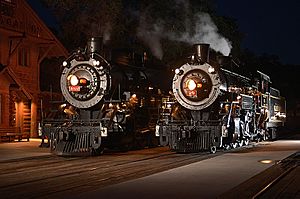
The older ALCO FA locomotives didn't have modern features. So, in 2003, the railway bought three newer F40PH locomotives from Amtrak. They started using them in 2004.
In March 2006, the Biegerts announced they were selling the railway. This included its restaurants, hotels, and other services. The business made almost $40 million a year. They wanted a new owner who would keep everything running together.
New Chapter: Xanterra Ownership
On September 21, 2006, Xanterra Parks & Resorts bought the Grand Canyon Railway. Xanterra is a company from Denver, Colorado. Xanterra used to be called the Fred Harvey Company. This company had ties to the Atchison, Topeka & Santa Fe Railway since 1876. They ran restaurants and hotels for the railway.
Xanterra said they would keep all 480 railway employees. They wanted to make the business grow. They also wanted to connect the railway better with Xanterra's other services at the Grand Canyon National Park. In 2005, the railway had over 225,000 passengers. It made over $38 million in revenue. Xanterra bought all the railway's property. This included depots, hotels, and the land the 65-mile (105 km) line runs on.
In September 2008, steam locomotive trips were stopped. Xanterra said it was because of high diesel fuel costs. They also worried about the environment. A steam locomotive used 1,450 gallons of diesel fuel for one roundtrip. A diesel-electric locomotive used only 550 gallons. Steam engines also used 1,200 gallons of water.
But steam locomotives returned on September 19, 2009! Xanterra changed them to run on waste vegetable oil. This oil is collected from restaurants in Northern Arizona. They also installed a rainwater collection system. This system fills the boilers when water is available.
Since 2011, steam locomotives run on special trips. They also run at least once a month during the summer. In 2017, the railway bought two more F40PH diesel engines. As of 2021, the Grand Canyon Railway has two steam locomotives left. In 2019, the railway bought three special business cars. These cars are used for private trips. They can be pulled by either steam or diesel engines.
Locomotive Roster
The Grand Canyon Railway uses different types of locomotives. Some are steam engines, and some are diesel engines. Here are some of the main ones they use:
| Number | Builder | Date | Type | Former railroad | Status | Notes |
|---|---|---|---|---|---|---|
| 29 | Alco | May 1906 | Steam SC-3 2-8-0 | Lake Superior and Ishpeming | Stored | This engine has been on the GCR since 1990. It is waiting for a required inspection. |
| 4960 | Baldwin | August 1923 | Steam O-1a 2-8-2 | Chicago Burlington and Quincy | Operational. | No. 4960 has a long history of special trips. It can pull up to twelve passenger cars. |
| 1105 | EMD | 1952 | Diesel gp7u | Atchison Topeka and Santa Fe | Operational | This engine is often used to move equipment. It also pulls the annual Pumpkin Patch Train. |
| 6793 | Alco | 1959 | Diesel PFA-4 | Canadian National, Via Rail | Operational | Used for the Williams Flyer train. |
| 6860 | Alco | 1958 | Diesel PFB-4 | Canadian National, Via Rail | Operational | Used for the Williams Flyer train. |
| 237 | EMD | 1977 | Diesel F40FH | Amtrak | Operational | Operating for the GCR since 2010. |
| 239 | EMD | 1977 | Diesel F40FH | Amtrak | Operational | Operating for the GCR since 2004. |
| 295 | EMD | 1979 | Diesel F40FH | Amtrak | Operational | Operating for the GCR since 2009. |
| 4124 | EMD | 1981 | Diesel F40FH | NJ Transit | Operational | Operating for the GCR since 2017. |
| 4128 | EMD | 1981 | Diesel F40FH | NJ Transit | Operational | Operating for the GCR since 2017. |
Operations: Riding the Grand Canyon Railway
The Grand Canyon Railway takes many people to the canyon. About 225,000 passengers ride it each year.
The train starts at the Santa Fe Railway Station in Williams. This is the southern end. The northern end is the Grand Canyon Depot. The National Park Service owns this station.
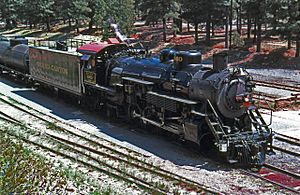
Most of the time, diesel locomotives pull the trains. These are F40PH diesel engines. They were changed to run at freight train speeds. Steam locomotives are used on special holidays. They also run on the first Saturday of each month from March to October. The railway also sometimes uses its historic ALCO FA diesel locomotives.
Passengers ride in comfortable coaches from the 1950s. These cars have air conditioning or heating. During busy times, you can also ride in older 1920s-era Pullman cars. These have windows that open!
To make the trip more fun, actors dress up as bandits. They stage a pretend train robbery on the way back to Williams. It's part of the Old West experience!
The Grand Canyon Railway runs at least one round trip every day. It goes between Williams and the Grand Canyon. The only day it doesn't run is Christmas Day. During very busy times, a second train is added.
| Station | Time |
|---|---|
| Leave Williams | 9:30 am |
| Arrive Grand Canyon | 11:45 am |
|
(time at Grand Canyon) |
|
| Leave Grand Canyon | 3:30 pm |
| Arrive Williams | 5:45 pm |
| Station | Time |
|---|---|
| Leave Williams | 10:30 am |
| Arrive Grand Canyon | 12:45 pm |
|
(time at Grand Canyon) |
|
| Leave Grand Canyon | 4:30 pm |
| Arrive Williams | 6:45 pm |
In the winter (November to January), the line runs The Polar Express. This train goes from Williams to the 'North Pole'. This 'North Pole' is a station about 17 miles (30 km) north of town. In 2008, about 78,000 people rode this special winter train.
The railway route used to have stops at Quivero, Valle, Willaha, and Coconino stations.
Historic Designations
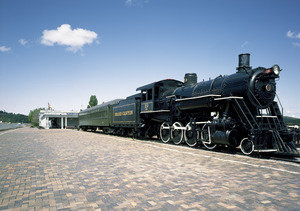
The entire Grand Canyon Railway is listed on the National Register of Historic Places. This means it's important to the history of the United States. The railroad helped open up the area north of Williams. It also helped build the Grand Canyon National Park facilities. It played a big part in starting tourism in the American Southwest. The railway also supported ranching, mining, and lumber industries. It even helped create a special culture around the railroad that still exists today.
The Grand Canyon Depot was added to the register on September 6, 1974. The Williams Depot and the rest of the railway line were added as a Historic District on August 23, 2000. The Grand Canyon Depot was also named a National Historic Landmark on May 28, 1987. This is because of its very important history.
Images for kids
-
GCRY's FPAs Nos 6776, 6793, and GP7uu 2134 at the Grand Canyon Village, 2008





